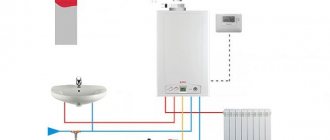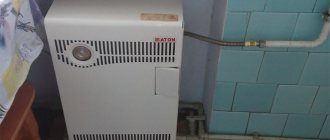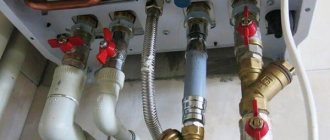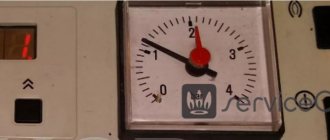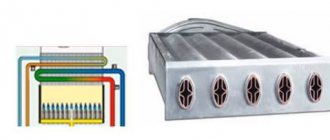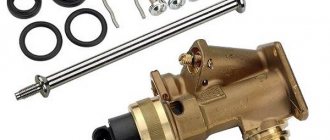Grounding system terms
Before moving on to considering the rules for installing grounding, it is necessary to define the terms used by specialists when carrying out this type of work.
- Firstly, what is a grounding device? This is a structure consisting of a grounding conductor and grounding conductors.
- Secondly, what is a ground electrode? This is a metal conductor that is directly connected to the ground.
- Third, what are grounding conductors? This is a system of metal conductors that connect the ground electrode to electrical equipment.
Please note that grounding an electrical installation artificially is called intentional. There is such a thing as the resistance of a grounding device. This is, in fact, the sum of the resistances of the grounding conductor and grounding conductors. If we talk about the resistance of the ground electrode itself, then this is the voltage relative to the ground to the current passing through the metal conductor.
Do I need to ground a gas boiler?
The position of the service and gas service workers, on the one hand, is understandable; this is what the instructions require, but on the other hand, it causes bewilderment. Why do you need to ground a gas boiler in an apartment or in a modern house, in which the wiring is in perfect order, there are circuit breakers and even an RCD.
After all, grounding is primarily required to protect against electric shock. The power of electrical equipment in a gas boiler is a maximum of 150 W less than that of a meat grinder or mixer. They do not require independent grounding.
To understand the reasons why grounding is needed for a gas boiler, just read the documentation for the heating equipment. As a result we get the following:
- The use of plastic parts of air ducts and fan pressurization of the boiler combustion chamber leads to the appearance of a large amount of static electricity. Therefore, grounding for a gas boiler is necessary in order to avoid a flash in the event of a domestic gas leak. As long as the heating system runs on methane, there is no particular danger, but if you suddenly need to use propane butane, which today is the main fuel for country houses and cottages, then the risk of fire increases hundreds of times;
- The second reason is the most obvious. Grounding a wall-hung gas boiler helps avoid damage to electronics and control boards.
For your information! The cheapest wall-mounted dual-circuit heating systems can cost hundreds of dollars in electronic components.
A power surge from a switched-on refrigerator can burn out the ignition board.
If the most modern and efficient condensate models are used to heat a house or apartment, in which an almost full-fledged computer is installed, then in the absence of grounding we are talking about costs of a much higher order. Not to mention the fact that it is necessary to ground a gas wall-mounted boiler so that the emerging static potential does not periodically knock down and affect the fine tuning of the boiler sensors.
Why do you need to ground a gas boiler?
A mandatory element of any gas boiler is a metal casing, on the surface of which static charges are formed when the device is connected to the network. And if you do not take care of the “escape routes” for electricity, at one unfavorable moment the entire electronic component of the device or its individual elements - for example, a board or control system - may fail.
To prevent this from happening, the boiler is “secured” by grounding - a conductor that connects the electrical appliance to the ground electrode, and the latter directly to the ground. The earth has the ability to “absorb” electric current, so its environment will be a guarantee of safety against equipment failure due to voltage surges or short circuits in the network.
Grounding is necessary to:
- Reduce the explosion hazard of the device - static electricity often causes spontaneous combustion of devices powered by gas, and even under pressure.
- Eliminate the possibility of injury - the metal case sometimes “pierces”, and when touched, a person can feel an electric shock from a slight tingling sensation to a powerful charge, followed by death.
- Prevent automation breakdowns - gas boiler boards are sensitive to voltage surges, and replacing them will cost at least a third of the cost of the equipment itself.
In addition, a boiler operating without grounding will have a lot of questions from gas service inspectors, which can result in significant fines and forced shutdown of the device. Therefore, it is worth equipping a grounding loop in any case, because we are talking not only about economic nuances, but also about your safety.
Correct choice of ground electrode
The easiest way to ground a gas boiler is to connect the ground terminal on the body of the heating system to a metal pipe leading into the ground, for example, to a water supply or sewerage system. As a result, if you open a hot water tap and touch the stream, you can get a noticeable electric shock. This method is not only ineffective, it is also unsafe for residents.
The worst option for "earth"
The second option, more common, involves connecting the grounding of a double-circuit gas boiler to a common “ground” in a private house. It turns out that all electrical appliances are located on one grounding bus, from a washing machine and electric kettle to a computer and TV. In this case, a strong surge in voltage only when the refrigerator or washing machine heater is turned on can easily damage the electronics of the gas boiler.
Therefore, the general requirements for grounding arrangement can be formulated in two points:
- The boiler body must be connected to a separate grounding loop, welded according to the rules of the Electrical Installation Code and installed in the ground in close proximity to the building;
- The resistance of the ground loop must comply with the standards and should not change or increase depending on weather conditions and seasons.
In addition, it is advisable to equip the circuit in a hidden version, so that it cannot be removed from the ground. Metal parts often become easy prey for scrap metal seekers, so for residents of apartments and country houses, the best option would be to equip a ground loop for a gas boiler somewhere in the basement with your own hands.
Standards and requirements for grounding a gas boiler
The main characteristics and design features of the safe grounding circuit are written in the operating rules for power installations PUE 1.7.59 and 1.7.103. In order not to go too deep into the study of regulatory documents, it is necessary to note the two most important requirements. Firstly, the soil resistance should be no more than 10 ohms for clay and 50 ohms for sand. In practice, a contour is made to the depth of soil freezing, regardless of its composition. Moreover, it is quite difficult to find sand and clay in their pure form, so you have to take precautions in case of a dry summer.
We recommend: Malfunctions of the Junkers gas boiler: error codes and methods for eliminating them
The metal of the tire and contour is not painted or treated with anticorrosive
Secondly, the cross-section of the bus laid from the body of the gas boiler to the circuit in the ground must be at least 75 mm2 for steel and 16 mm2 for aluminum. If suddenly someone decides to lay a copper busbar, then its cross-section can be reduced to 10 mm2.
What is needed for grounding gas boilers
First of all, you need to take care of the structure itself. There are two options for grounding a gas boiler for heating in a private house: assemble it yourself and buy a ready-made grounding kit. The cost of the product starts from eight thousand rubles. Gas services support the option of a ready-made kit, however, they have nothing against creating an individual kit. The only condition during work is to adhere to all the norms and requirements prescribed in the PUE.
We recommend: Installation of an expansion tank in the heating system, connection and installation
Metal rods are good for grounding
To ground a double-circuit gas boiler in a private house, you must use zinc or black steel. In rare cases, copper is used, however, this option is expensive. It is strictly forbidden to paint the structure. The easiest way to ground a gas boiler for a private home is to use:
- 3 stainless steel corners, 2 m long and 50/50 mm in size. A water supply line can also be used, however, the diameter and thickness should not be less than 30/4 mm;
- rectangular profiles with a cross-section of 110 mm2, as well as 3 steel strips cut from them, 5 cm wide, 1.5 m long and 5 mm thick. It is allowed to use other options that comply with the standards;
- 1 steel strip made of rectangular stainless steel profile. The length from the top point of the triangle to the ground near the building should not exceed 4 m, width - 4 cm, and thickness - 4 mm;
- copper wire PV-3 with a cross-section not exceeding 12 mm2. You can also use aluminum or steel conductor with 16/75 mm2 respectively. It is worth noting that industrial wires use 15 mm2;
- bolts M10 and M8.
Next, you will need to calculate the parameters that are necessary for the desired resistance. In this case, you can use the following soil indicators:
- clayey – 10 Ohm/m;
- sandy – 50 Ohm/m;
- chernozem or garden soil - 30 Ohm/m;
- sand-clay – 150 Ohm/m.
It is very important to remember that the physical properties of the ground loop will depend on both the type of land cover and the climatic conditions in the region. Taking these circumstances into account, the design developed for a private house must be checked, and if unsuccessful, changes must be made to the circuit. You can determine the properties of the kit using the instructions:
- Fasten the horizontal and vertical lines, twist them tightly into one chain.
- Take measurements on the assembled structure using an ohmmeter. The indicator should vary between 5-8 Ohm/m. This parameter is optimal for all types of soil. If the measurements coincide, it means that the design for a private house was done correctly.
- If the permissible parameters are exceeded, the design must be corrected by adding several additional elements with a larger diameter.
The inspection must be carried out by representatives of the gas service. Attention! Despite the standard indicators, city gas employees may request a resistance of 10 Ohm/m for ordinary soil.
Boiler grounding methods
There are several ways to install a ground loop:
- According to the type of device, there is a need for separate grounding of the gas boiler. Household appliances: washing machines, refrigerators, kettles, etc., have different parameters and technical characteristics from heating equipment. PUE have higher requirements for connecting a gas boiler. Therefore, if you plan to install grounding through a socket, it must be connected not to the switchboard, but directly to the circuit.
- According to the manufacturing features - the connection is made with a ready-made kit, specially made for connection to a gas boiler, or using improvised materials.
The PUE relating to grounding describes rules prohibiting the use of a water supply, sewer or gas pipe as grounding when connecting a boiler.
How to ground a gas unit?
How to properly ground a gas boiler? First, you should consider a number of important nuances:
- For a grounding metal structure installed in the ground, the following are suitable: angle, channel, profile pipe.
- The metal surface must be protected from corrosion: galvanizing, copper coating or anti-corrosion paste.
- The cross-sectional area of the wire connecting the zero phase of the shield to the ground loop for a gas boiler depends on the type of metal. For copper, 1 cm² is considered optimal, for steel – 7.5 cm², for aluminum – 16 cm².
- The grounding resistance for sandy soils should not be more than 50 Ohms, for alumina - up to 10 Ohms.
- The electrodes must be made of a material that matches the circuit resistance. The best option is two-inch pipes or corners with a length of 2 m and a cross-sectional area of 6 cm².
- The bus must be made only from steel or copper strip.
Compliance with the above conditions will relieve you of claims from inspection authorities.
What will be needed to arrange grounding?
If you want to ground boiler equipment yourself, you will need:
- The wire that will go from the shield to the circuit in the ground. Its cross-section depends on which wire is used. Copper - from 10 sq. mm, aluminum – from 16 sq. mm, steel – from 75 sq. mm.
- Pins that will be driven into the soil. You can use ordinary steel pipes or angles. They are all connected by a busbar, fastened with spot welding. If you order an already assembled kit, it will contain special electrodes.
- RCD and automation. According to current standards, it is impossible to install an RCD if there is no grounding.
We recommend: Open heating system and closed one - which is better and what to choose?
| Material | Section profile | Diameter, mm | Cross-sectional area, mm2 | Wall thickness, mm |
| Black steel | Round: | |||
| — for vertical grounding conductors | 16 | — | — | |
| — for horizontal grounding conductors | 10 | — | — | |
| Rectangular | — | 100 | 4 | |
| Angular | — | 100 | 4 | |
| Pipe | 32 | — | 3,5 | |
| Cink Steel | Round: | |||
| — for vertical grounding conductors | 12 | — | — | |
| — for horizontal grounding conductors | 10 | — | — | |
| Rectangular | — | 75 | 3 | |
| Pipe | 25 | — | 2 | |
| Copper | Round | 12 | — | — |
| Rectangular | — | 50 | 2 | |
| Pipe | 20 | — | 2 | |
| Stranded rope | 1.8 (for each wire) | 35 | — |
The grounding work itself is carried out in the following way:
- A ditch model is made on the soil in the shape of an isosceles triangle. After this, a ditch is dug, the width of which is up to 40 cm and the depth is about 50 cm.
- Special holes are drilled in each of the three corners. This can be done using a motor drill or another method.
- Pipes or corners are clogged into the holes.
- The triangle is scalded with a 4-centimeter strip. The same strip extends to the house.
- A 10 mm pin is welded in and secured to the base of the building. If necessary, it can be hidden using a small PVC box. After this, wires are connected from the stud itself to the boiler.
As you can see, the task is not the easiest and quite labor-intensive. Plus it requires a clear understanding of the matter. The question of whether it is necessary to ground a gas boiler is not worth it. But doing it yourself or buying a ready-made solution is your choice. Most people lean towards the latter option.
Boiler grounding methods
There are several ways to install a ground loop:
- According to the type of device, there is a need for separate grounding of the gas boiler. Household appliances: washing machines, refrigerators, kettles, etc., have different parameters and technical characteristics from heating equipment. PUE have higher requirements for connecting a gas boiler. Therefore, if you plan to install grounding through a socket, it must be connected not to the switchboard, but directly to the circuit.
- According to the manufacturing features - the connection is made with a ready-made kit, specially made for connection to a gas boiler, or using improvised materials.
The PUE relating to grounding describes rules prohibiting the use of a water supply, sewer or gas pipe as grounding when connecting a boiler.
What should the ground loop resistance be?
The required resistance for grounding when connecting a gas boiler depends not only on the characteristics of the heating equipment, but also on the soil. The following standards are specified in PUE 1.7.103:
- Clay soil - the permissible resistance should not exceed 10 Ohms. The standard is valid for single-phase current and line voltage (380 V).
- Sandy soil - the maximum resistance of the grounding device should be no more than 50 Ohms.
Representatives of the gas industry often rely on paragraph PUE 1.7.59, according to which the minimum requirements are higher than in 1.7.103. In normal soil, the resistance should not be higher than 10 ohms.
Assembly and installation of the grounding loop
If for some reason it is not possible to assemble a full-fledged grounding loop from a steel angle, then, as an alternative, you can use a modular grounding kit of type Z 000 0-15. Essentially, it is a long drill rod that is buried in the ground to a depth of 2 m and provides effective and reliable grounding even for highly loaded electrical generators. It can be installed in the basement of the house, and the connection bus is made in the form of a copper wire with a cross-section of 15-25 mm2.
The classic version of the contour is welded by spot welding from steel corners with a length of at least 200 cm each. All three corners are connected or tied with a mounting busbar with a cross-section of 75 mm, usually this is a standard 40x4 mm electrical busbar, used to make earth for gas and electric boilers.
Circuit diagram
For installation in the ground, it is necessary to dig at least a pit or three trenches in the form of a triangle to a depth of at least a meter. Next, with a garden drill, another 20-30 cm of recess is punched in the tops. The distance between them should be at least 3 m.
Each stake is cut at an angle from the inside. Before hammering in a corner, pour water into the hole and leave it for a couple of hours to soften the soil. The stake only needs to be driven in, either with a sledgehammer or with a hand hopper, but no options with laying the angle into the drilled hole are allowed.
It will be necessary to weld a threaded rod under the contact
The tops of the stakes are tied by welding with horizontal jumpers. The busbar coming from the gas boiler is connected to the nearest corner, and the contact is fixed with a metal plate, which is also welded.
How to connect grounding to a gas boiler
After the circuit has been assembled and welded, you need to make sure that the contact between the end of the tire on the body of the gas boiler and the metal of the stakes is stable and does not disappear even when lightly tapping the metal strapping with a hammer. Standard grounding, made for a gas boiler with your own hands, should not disappear under soil pressure, during its settlement and heaving, regardless of weather and air temperature.
We recommend: GSM module for boiler - functions, models and prices, setup instructions
Strapping diagram with grounding jumpers
The grounding bus terminal is attached to the supporting frame of the boiler; it is usually assembled from an aluminum or galvanized profile. Separately, you will need to run a grounding cable to the automation housing and to the electronics board. For a wall-mounted gas boiler, you need to make your own grounding for the suction pipe. It is here that the potential for static electricity appears in dry, windy weather.
Cost of organizing boiler grounding
To calculate how much it will cost to connect the boiler, you will need to calculate the ground loop. Several factors influence the cost:
- Soil type.
- Selected electrode material and wire thickness.
- Type of grounding used.
Another factor that is often not taken into account is which organization will carry out the audit and issue a protocol for testing the resistance of grounding conductors and grounding devices.
In a modular gas boiler room, a special metal strip or bus is provided, to which the “ground” is connected from all metal structures and electrical components. To connect, you need to install metal electrodes in the ground and connect the circuit and the output terminal with a wire.
Selection of materials for the ground electrode
To install grounding conductors for a gas boiler in a private house, as well as for a lightning rod, rods, pipes, and horizontal conductors are connected to each other with iron strips in the thickness of the earth. The system must work even in the most severe frosts.
All products should be protected against corrosion, but not by insulation. It is better to choose electrodes made of stainless steel or copper (ready-made home systems are usually made of copper). The wires from the shield to the circuit are made of copper or aluminum, the connecting parts (in ready-made kits that do not require welding) are made of brass.
Calculation of parameters and resistance when installing grounding
Control services place high demands on grounding systems in a private home. So, the calculation of resistance will depend on the type of soil in the area. To determine the resistance, you need a special device (meter), but more often grounding in a private house is done experimentally:
- Take rods 3 meters long and solder them together.
- Use an ohmmeter to measure the circuit resistance.
- When you receive a value higher than 4 - 10 Ohms (for normal soil), introduce another element into the circuit. Do this until the number falls within the specified interval. For sandy soil the indicator may be 50 ohms.
Experts calculate the indicator using the formula. This will be required if the soil on the site is heterogeneous and stratified. The worst place for installing grounding on a lightning rod or gas boiler is rocky, rocky soil (you will need to make an artificial embankment). In difficult cases, it is better not to find out how to make a grounding or lightning rod, but to entrust the calculation to a specialist.
Grounding installation
To install the system in a private home, you need to carry out a number of works. You need to find a place no further than 5 meters from the house, where no other work, planting, or construction will be carried out. You cannot enter the site when it is ready; it is better to securely fence it off with a stone, fence, or curb.
Preparation and drafting of the project
As with the installation of a lightning rod, for a gas boiler a circuit with a grounding electrode must first be designed. The layout should be drawn on paper: usually the diagram is an equilateral triangle with sides up to 2.5 meters long, less often - a square, pentagon, or line. The last option is done to save space near a private house.
Preparation includes collecting the necessary equipment and checking its serviceability:
- welding machine;
- drill, hammer drill;
- Bulgarian;
- shovel, sledgehammer;
- motor drill for hard soil.
After this, you can go directly to work.
Loop connection
The first stage of installing a lightning rod for a gas boiler is digging a trench up to forty centimeters wide and up to seventy centimeters deep. The near corner of the triangle (or other selected element) is directed towards the house, and a straight groove is dug from it towards the base. Then slightly pointed steel conductors are taken along the vertices of the triangle (their ends are sharpened with a grinder). The upper edge of the electrodes should protrude 20 cm from the ground; at the end of the work they are covered with earth.
The electrodes in the trench are connected with steel conductors or strip. They need to be welded carefully so that the quality of the seams is high. For ready-made kits, the conductors are connected with special bolts.
Next, a metal strip is spot welded to the contour and taken to a private house at the site of the intended entrance. You need to raise the strip by fifty centimeters using a steel pin, weld an M8 iron bolt, attach a copper cable, and lead it home. The boiler itself is connected to the panel via an RCD with a three-wire wire.
Checking work
Testing the device involves assessing the current loop resistance. The indicator should not exceed 10 Ohms; if the result is successful, you need to dig a trench. If there are problems, add electrodes and measure the resistance again. For digging, use high-quality soil without stones. The entry point of the home wire is covered with a visor that protects from water.
We recommend: Calculating the diameter of a pipe for heating a private house: how to calculate heating with natural and forced circulation, coolant speed in the system, table, what diameter is needed according to the cross-section of the pipeline
When ready, you can call specialists to draw up a grounding report. When checking, the technicians will compare the indicators with the resistance standards and evaluate the correctness of the wire connection to the panel. The completed report should be kept at home in case of an inspection.
Lightning rods and grounding conductors for gas boilers are an integral part of heating; they must be planned without fail. This will protect people from accidents and protect equipment from damage.
Do I need to ground the gas boiler myself or entrust the work to a specialist?
The design of the circuit is prepared before installation.
The document can use both the triangle shape presented in the article and shapes with a large number of sides. The main thing is at least two.
The more sides and electrodes, the lower the resistance will be.
In ready-made grounding kits, the circuit is usually already included.
To avoid emergency situations, a number of grounding requirements must be observed. The PES establishes that the resistance of the circuit should be no more than 10 Ohms in normal soil and 50 Ohms in dry sandy soil.
The cross-section for the wire connecting the shield to the circuit is allowed as follows:
- copper wire - at least 10 sq. mm;
- aluminum - 16 sq. mm;
- steel - 75 sq. mm.
To install a grounding system, you will need the following materials:
- electrodes, namely: a metal corner measuring 5x5 cm or building reinforcement with a diameter of at least 16 square meters. millimeters;
- metal plates with a thickness of at least 40 cm, width - 4 cm;
- bolt connector.
To work with these materials you will need the following tools:
- welding machine if the plates will not be bolted;
- shovel for digging a trench;
- sledgehammer or hammer drill;
- grinder to cut off excess pieces of metal.
READ MORE: How to choose insulation for water heated floors
Reference! Instead of a welding machine, you can use a drill with metal drills and attach the plates to the bolts.
The process of grounding a gas boiler in a house:
- Select a suitable ground electrode. A choice between artificial and natural grounding is allowed.
Then you should select a suitable location where the installation will be carried out. It is necessary to dig three trenches in the ground for the ground loop, about 50 cm deep and at least 120 cm long each.- You should get a triangle, into the corners of which electrodes are driven. If the soil is hard, you can drill holes with a motor drill. The upper part of the electrode should lie below the freezing depth of the mail - on average, 70 centimeters.
- Then connect the electrodes to each other with metal plates. Some sets are connected by welding, others by bolts. The thickness of the plate is at least 40 cm, width is 4 cm.
- The plate from the triangle is led to the house. A bolted connector is welded to the plate, to which the grounding wire leading to the switchboard is screwed.
- The ground loop is buried in the ground.
Grounding bus for a floor-standing or wall-mounted boiler in a private house
There are two main reasons why you should pay attention to connecting the steel heater body to the grounding bus:
- Electronic control systems of the installation are sensitive to various surface currents or static that accumulates on metal parts during operation. The consequence of exposure to such undesirable factors may be a malfunction of the processor or its failure.
- In case of possible gas leaks, the appearance of a spark in most cases leads to an explosion. Grounding neutralizes any potentials or leaks, eliminating the possibility of an accident.
PUE 1.7.103 does not indicate that you need to buy a ready-made grounding kit. However, the gas service recommends just such solutions - they are more reliable and safer. If you have knowledge and experience, the homeowner can make the outline himself. But such work is usually more difficult. There are many factors to consider:
- what type of grounding can be used in your system;
- what resistance parameters;
- what materials are recommended for your ground loop.
The most common grounding methods:
- Depending on the device. If you need to ground the unit, you can do it through an outlet. But this is only possible if the outlet is connected to the circuit itself, and not to the panel board.
- Depending on the specifics of production. Grounding can be done using a ready-made kit or done by yourself.
An important parameter when grounding is the loop resistance. It depends both on what kind of boiler is used and on the type of soil in the area. For clay soils this value should not be more than 10 ohms, and for sandy soils - up to 50 ohms. These standards are also specified in PUE 1.7.103.
If you want to ground boiler equipment yourself, you will need:
- The wire that will go from the shield to the circuit in the ground. Its cross-section depends on which wire is used. Copper - from 10 sq. mm, aluminum – from 16 sq. mm, steel – from 75 sq. mm.
- Pins that will be driven into the soil. You can use ordinary steel pipes or angles. They are all connected by a busbar, fastened with spot welding. If you order an already assembled kit, it will contain special electrodes.
- RCD and automation. According to current standards, it is impossible to install an RCD if there is no grounding.
| Material | Section profile | Diameter, mm | Cross-sectional area, mm2 | Wall thickness, mm |
| Black steel | Round: | |||
| — for vertical grounding conductors | 16 | — | — | |
| — for horizontal grounding conductors | 10 | — | — | |
| Rectangular | — | 100 | 4 | |
| Angular | — | 100 | 4 | |
| Pipe | 32 | — | 3,5 | |
| Cink Steel | Round: | |||
| — for vertical grounding conductors | 12 | — | — | |
| — for horizontal grounding conductors | 10 | — | — | |
| Rectangular | — | 75 | 3 | |
| Pipe | 25 | — | 2 | |
| Copper | Round | 12 | — | — |
| Rectangular | — | 50 | 2 | |
| Pipe | 20 | — | 2 | |
| Stranded rope | 1.8 (for each wire) | 35 | — |
The grounding work itself is carried out in the following way:
- A ditch model is made on the soil in the shape of an isosceles triangle. After this, a ditch is dug, the width of which is up to 40 cm and the depth is about 50 cm.
- Special holes are drilled in each of the three corners. This can be done using a motor drill or another method.
- Pipes or corners are clogged into the holes.
- The triangle is scalded with a 4-centimeter strip. The same strip extends to the house.
- A 10 mm pin is welded in and secured to the base of the building. If necessary, it can be hidden using a small PVC box. After this, wires are connected from the stud itself to the boiler.
As you can see, the task is not the easiest and quite labor-intensive. Plus it requires a clear understanding of the matter. The question of whether it is necessary to ground a gas boiler is not worth it. But doing it yourself or buying a ready-made solution is your choice. Most people lean towards the latter option.
So, you have received an affirmative answer as to whether the boiler needs to be grounded. Many owners of heating systems, in an effort to save money, decide to do the work themselves. We don't recommend doing this. If even minor mistakes are made, at best you will not be issued an inspection report. At worst, it will cause breakdowns, shortening the life of the boiler, and emergency situations. It may even pose a threat to property, health and life.
If you need to ground the boiler and you do not want to do it yourself due to lack of experience or for other reasons, contact Profteplo. We will select ready-made solutions and carry out grounding at a time convenient for you. We also provide maintenance, service, and repair of gas and other types of boilers in case of malfunction.
How to ground a gas boiler yourself
The design of the circuit is prepared before installation.
The document can use both the triangle shape presented in the article and shapes with a large number of sides. The main thing is at least two.
The more sides and electrodes, the lower the resistance .
In ready-made grounding kits, the circuit is usually already included.
Tools and materials
To install a grounding system, you will need the following materials:
- electrodes , namely: a metal corner with dimensions of 5x5 cm or construction fittings with a diameter of at least 16 square meters. millimeters;
- metal plates with a thickness of at least 40 cm , width - 4 cm;
- bolt connector.
To work with these materials you will need the following tools:
- welding machine if the plates will not be bolted;
- shovel for digging a trench;
- sledgehammer or hammer drill;
- grinder to cut off excess pieces of metal.
Reference! Instead of a welding machine, you can use a drill with metal drills and attach the plates to the bolts.
The process of grounding a gas boiler in a house:
- Select a suitable ground electrode. A choice between artificial and natural grounding is allowed.
- Then you should choose a suitable place where the installation will be carried out. three trenches in the ground for the ground loop, about 50 cm and at least 120 cm long each.
- You should get a triangle , into the corners of which electrodes are driven.
If the soil is hard, you can drill holes with a motor drill. The upper part of the electrode should lie below the freezing depth of the mail - on average, 70 centimeters. - Then connect the electrodes to each other with metal plates . Some sets are connected by welding, others by bolts. The thickness of the plate is at least 40 cm, width is 4 cm.
- The plate from the triangle is led to the house . A bolted connector is welded to the plate , to which the grounding wire leading to the switchboard is screwed.
- The ground loop is buried in the ground.
How to properly ground a gas boiler
The PUE stipulates the need for grounding, but does not stipulate that it is necessary to purchase a ready-made grounding kit (although this is recommended by representatives of the gas service). The outline can be made with your own hands.
In order to do the work yourself and correctly, take into account the following nuances:
- Possible type of grounding system.
- Resistance parameters.
- Recommended materials for making a grounding loop.
- Cost of work.
The grounding loop for connecting a gas boiler must strictly comply with the standards and parameters specified in the PUE. If the inspection shows a deviation from the standards specified in the documentation, the representative of the Gas Service has the right to refuse to put the equipment into operation.
Boiler grounding methods
There are several ways to install a ground loop:
- According to the type of device, there is a need for separate grounding of the gas boiler. Household appliances: washing machines, refrigerators, kettles, etc., have different parameters and technical characteristics from heating equipment. PUEs have higher requirements for connecting a gas boiler. Therefore, if you plan to install grounding through a socket, it must be connected not to the switchboard, but directly to the circuit.
- According to the manufacturing features - the connection is made with a ready-made kit, specially made for connection to a gas boiler, or using improvised materials.
The PUE relating to grounding describes rules prohibiting the use of a water supply, sewer or gas pipe as grounding when connecting a boiler.
What should the ground loop resistance be?
The required resistance for grounding when connecting a gas boiler depends not only on the characteristics of the heating equipment, but also on the soil. The following standards are specified in PUE 1.7.103:
- Clay soil - the permissible resistance should not exceed 10 Ohms. The standard is valid for single-phase current and line voltage (380 V).
- Sandy soil - the maximum resistance of the grounding device should be no more than 50 Ohms.
Representatives of the gas industry often rely on paragraph PUE 1.7.59, according to which the minimum requirements are higher than in 1.7.103. In normal soil, the resistance should not be higher than 10 ohms.
What materials are needed for grounding
Grounding requirements when connecting a gas boiler also affect the types of materials used during installation work. The following recommendations exist:
- The grounding wire from the shield to the circuit laid in the ground must be of the following cross-section: copper - at least 10 mm², aluminum - 16 mm², steel - 75 mm².
- As vertical pins driven into the ground, steel pipes or angles are used, connected by a tire to each other using spot welding. Ready-made kits include galvanized or copper-plated electrodes.
- Automation and RCD - the boiler is connected to a panel with installed electrical fittings. The PUE prohibits the installation of an RCD with a gas boiler without grounding. But duplication of the safety system is allowed when the grounding loop is simultaneously installed together with the residual current device.
Cost of organizing boiler grounding
To calculate how much it will cost to connect the boiler, you will need to calculate the ground loop. Several factors influence the cost:
- Soil type.
- Selected electrode material and wire thickness.
- Type of grounding used.
Another factor that is often not taken into account is which organization will carry out the audit and issue a protocol for testing the resistance of grounding conductors and grounding devices.
In a modular gas boiler room, a special metal strip or bus is provided, to which the “ground” is connected from all metal structures and electrical components. To connect, you need to install metal electrodes in the ground and connect the circuit and the output terminal with a wire.
Sources
- https://assistentus.ru/forma/akt-na-zazemlenie-gazovogo-kotla/
- https://fb.ru/article/277408/dlya-chego-nujno-zazemlenie-gazovogo-kotla
- https://elone.ru/customer/docs/protocoly
- https://sovet-ingenera.com/elektrika/zemlya/kak-sdelat-zazemlenie-dlya-gazovogo-kotla.html
- https://avtonomnoeteplo.ru/otopitelnye_kotly/379-kak-sdelat-zazemlenie-dlya-gazovogo-kotla.html
How to check grounding on a gas boiler
The quality of grounding for a wall-mounted boiler in a private house must be checked by the relevant authorities. Gas service employees draw up a report and put the kit into operation. In another case, in accordance with the PUE standards, the electrical laboratory is required to carry out the inspection. Representatives of this organization take readings from the panel and measure the resistance of the structure using a sensor. In case of compliance with the rules of electrical installations, a permit for the use of a ground loop is drawn up. If the sensor indicators do not reach the specified measurements, then the kit for a private house is subject to further refinement.
Requirements for grounding a gas boiler
The official document PUE provides a set of regulatory rules and requirements that describe in detail the scheme for connecting the grounding of a gas boiler to a private house. In accordance with the established standards, a special circuit must be attached that conducts the electric charge into the ground near a private house. But the documents do not provide precise instructions regarding the type of equipment – homemade or industrial.
The regulations for the rules of electrical installations include a list of elements that are not allowed to be used for the grounding loop:
- heating and sewerage pipeline units;
- metal structures of standard gas pipelines and pipes of other explosive substances.
In accordance with the rules, it is allowed to use drainage lines that are located in the ground near a private house. Reinforced concrete units with good waterproofing and other steel structures located in the ground will be useful. If such elements are missing, you will have to construct a ground loop yourself.
Rules for grounding pipelines
In the process of laying pipelines for any purpose, it is necessary to take care of the safety of their operation. It is important to prevent the negative impact of a strong electrical discharge on both the pipeline itself and the substances transported through it. Especially for this it is important to install grounding.
Main features
When installing a grounding system, a connection to the building's lightning protection system is necessary. With its help, possible impact on the raw materials transported inside is completely eliminated. This is especially true in cases where there is an explosive substance inside - gas, oil, alcohol and other flammable materials.
To ground the pipeline, it is necessary to connect the current-carrying strip to a grounded metal object. Copper wire is used for this, since copper is considered an excellent conductor. At least one grounding connection is made for every twenty meters.
If the main line is assembled from a paper-metal pipe, the metal shells must be connected to each other, as well as to the bodies of boxes, electrical receivers or boxes. When performing work, you will need jumpers made of bare copper conductor with a good margin of flexibility.
Experts recommend using conductors with a cross-section of at least 2.5 square meters. Moreover, you cannot save in this regard, even paying attention to the high cost of copper. It is enough to secure it at each end of the pipes using a wire bandage, or by soldering the outlet to the body and the pipe itself using a soldering iron.
It is important to remember that for proper grounding, metal parts should be installed every 20 meters. In this case, they will also have to be permanently connected using a tap.
Copper wire
Practice shows that the most popular method by which pipelines are grounded is the use of copper wire. It is recommended to use wire with a diameter of 1...1.5 mm. It is carried out both from the inside and from the outside, fastening it together at the joints using a wire jumper. The cold soldering method is used for connection. The outer wire installed at the end point needs to be carefully grounded.
Grounding the pipeline is the simplest, but at the same time mandatory, method of removing accumulated static charges of electricity. The main measure that prevents the occurrence of discharges accompanied by a spark is grounding with full shunting of taps and couplings. The operation is performed using copper wire.
It is worth noting that the use of grounding technology in water pipes can significantly reduce the potential between the walls and the liquid itself, which is transmitted through it. However, no grounding system can completely eliminate the electrification of liquid substances.
Basic Rules
It is mandatory to ground the pipeline - this requirement is specified in the PUE. Although at first glance the pipeline and electrical installations have little in common, being a metal structure, it can carry current and pose a danger. The use of grounding makes it possible to significantly increase the level of safety during installation or repair. When operating a pipe system, the transferred substance tends to generate static electricity. In addition, no one excludes the possibility of a direct lightning strike hitting the pipe.
According to current rules, not only external pipelines are subject to grounding, but also internal ones. The latter include communication and technology.
The PUE regulates the main features of pipeline grounding arrangement:
- the tubular system must be a continuous network that is connected into a single circuit;
- the pipeline must be connected to grounding at at least 2 points. Their number directly depends on the length of the highway, technical features, and so on.
Regarding the first rule, this is not a reason to assume that the pipeline system must always have a continuous structure. In this case, you need to remember that individual pipelines or sections should be connected into one network. To perform this task you will need a wafer jumper.
The quantity again depends on the design features. The jumpers can be fixed to the pipeline by bolting, welding or installing a special clamp, which ensures high-quality grounding of metal pipes. The wafer jumper is a wire made of copper, marked PuGV or PVZ.
Regarding the second rule, experts recommend abandoning the spread of grounding throughout the entire production line. You can get by with a connection at the end and beginning of a separate or single circuit.
Pipe stands
To install an entry device in a commercial building or country house, you must use a pipe stand. Its main task is to fix the power wire that leads to the shield, as well as install the shield itself. According to the requirements of the PUE rules, the pipe stand requires mandatory grounding.
Not far from the shield, you need to drill a hole through which it is important to place a grounding bolt. Both the pipe stand itself and the shield require high-quality grounding. A metal corner one and a half meters long should be driven in not far from the rack. Next comes the connection of the pipe stand, shield and corner.
The zero bus is also protected. The neutral wire marked SIP4, which comes from the support, must be connected to it. To perform the operation, you need to use the yellow-green wire marked PV-3, on which the tips are installed. At this point, the grounding of the metal pipe stand can be considered complete.
Effect of insulation
The insulation resistivity indicator can significantly influence the characteristic features of the pipeline. According to studies, the level of resistance in the grounding of a pipeline using bitumen insulation can greatly depend on the potential difference between the soil and the pipeline itself.
If the difference varies within a few hundred volts, glow discharge may occur at defective locations, which in turn reduces the ground resistance. If the potential difference is one kilovolt or more, an arc discharge appears between the soil and the pipeline. It, accordingly, greatly reduces the resistance of the installed grounding.
Portable grounding can also be used, in which the clamp is the main part.
Explosive areas
In some cases, explosive workshops operate on the territory of manufacturing enterprises. Here it is important to efficiently remove static electricity that occurs during the friction of a liquid-like substance against the internal walls of the pipes. In the process of arranging such structures, natural grounding is usually created, which passes through the equipment and building structures. However, this is not enough.
In such situations, it is necessary to reduce the potential removal. A good measure is to install an intermediate grounding of the pipeline and use cable conductors with a non-metallic sheath. These, for example, include the AASHV brand.
Advice from professionals
According to experts, if we are talking about self-assembly, the quality of grounding of a gas wall-mounted boiler for a private home largely depends on the materials chosen. It is not recommended to use existing structures that have been dug into the ground for an unknown period of time. The problem is that such nodes may have an insufficient cross-section. Also, old metal structures lose conductivity after a long time.
Despite the high cost of the products, when creating grounding for a private home, it is better to use copper wire with a large cross-section. Such an element guarantees a long service life with minimal risk to the unit. The structure must be spot welded, since the seams must be neat and small.
Advice! If it is possible to purchase an industrial kit, then for safety reasons it is better to choose this option.
